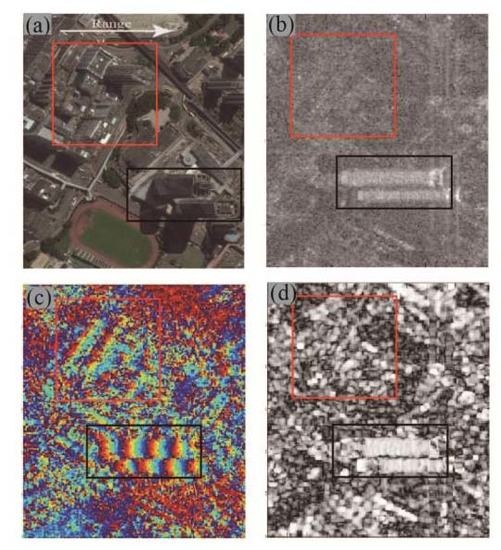High-Rise Building Layover Exploitation with Non-Local Frequency Estimation in SAR Interferograms
Abstract
:1. Introduction
2. Building Signature
3. Proposed Methodology
3.1. Local Frequency Estimation and Building Layover Patch Detection
3.2. Layover Removal
- (1)
- The LD phase, corresponding to sparse fringe patterns of the topography.
- (2)
- The HD phase, corresponding to the dense fringe pattern generated by the high-rise building. This is a superposition of the phase fringe contained by the layover, roof, and possible overlay of buildings.
3.2.1. LD Frequency Estimation
3.2.2. HD Frequency Estimation
3.3. Workflow
- (1)
- First, the interferogram provided by two co-registered SLC images is used to calculate the local frequency in the range direction. An improved estimation method using a non-local strategy is proposed to obtain a high-accuracy result and preserve the edge of the building layover. The final output is obtained by applying a classification method and morphology filtering.
- (2)
- Second, a two-step method is applied to eliminate building layover phases. We estimate the main terrain fringe pattern with an adaptive boxcar window. After these fringe patterns are removed, the non-local algorithm is used to estimate the secondary frequency produced by the phase of the building. We obtain the final result by removing the associated phase of the building from the initial interferogram.
4. Experiments and Discussion
4.1. Test Data
4.2. Non-Local Frequency Estimation
4.3. Building Layover Detection
- (1)
- The overlapping of layover phases caused by buildings in high-density areas affects the quality of fringe patterns, and it also changes the local frequency of building layover. Moreover, as shown in optical images, this is impossible to avoid in urban areas.
- (2)
- The phase of ground objects in the layover areas, such as trees and water, reduces the phase coherence greatly. In Figure 8a, this area contains a large range of vegetation, which increases the difficulty of data processing.
4.4. Building Layover Removal
4.4.1. Synthetic Test
4.4.2. Real Data Test
5. Conclusions
Acknowledgments
Author Contributions
Conflicts of Interest
References
- Dubois, C.; Thiele, A.; Hinz, S. Building detection and building parameter retrieval in InSAR phase images. ISPRS J. Photogramm. Remote Sens. 2016, 114, 228–241. [Google Scholar] [CrossRef]
- Rossi, C.; Eineder, M. High-resolution InSAR building layovers detection and exploitation. IEEE Trans. Geosci. Remote Sens. 2015, 53, 6457–6468. [Google Scholar] [CrossRef]
- Shahzad, M.; Zhu, X.X. Automatic detection and reconstruction of 2-D/3-D building shapes from spaceborne TomoSAR point clouds. IEEE Trans. Geosci. Remote Sens. 2016, 54, 1292–1310. [Google Scholar] [CrossRef]
- Sportouche, H.; Tupin, F.; Denise, L. Extraction and three-dimensional reconstruction of isolated buildings in urban scenes from high-resolution optical and SAR spaceborne images. IEEE Trans. Geosci. Remote Sens. 2011, 49, 3932–3946. [Google Scholar] [CrossRef]
- Thiele, A.; Wurth, M.; Even, M.; Hinz, S. Extraction of building shape from tandem-x data. In Proceedings of the International Archives of the Photogrammetry, Remote Sensing and Spatial Information Sciences, Volume XL-1/W1, ISPRS Hannover Workshop, Hannover, Germany, 21–24 May 2013; Volume 1, pp. 345–350. [Google Scholar]
- Thiele, A.; Cadario, E.; Schulz, K.; Thonnessen, U.; Soergel, U. Building recognition from multi-aspect high-resolution InSAR data in urban areas. IEEE Trans. Geosci. Remote Sens. 2007, 45, 3583–3593. [Google Scholar] [CrossRef]
- Zhang, F.; Shao, Y.; Zhang, X.; Balz, T. Building L-Shape Footprint Extraction from High Resolution Sar Image. In Proceedings of the 2011 Joint Urban Remote Sensing Event, Munich, Germany, 11–13 April 2011; pp. 273–276. [Google Scholar]
- Feng, D.; Chen, W. Structure filling and matching for three-dimensional reconstruction of buildings from single high-resolution SAR image. IEEE Geosci. Remote Sens. Lett. 2016, 13, 752–756. [Google Scholar] [CrossRef]
- Lee, J.; Hoppel, K.W.; Mango, S.; Miller, A.R. Intensity and phase statistics of multilook polarimetric and interferometric SAR imagery. IEEE Trans. Geosci. Remote Sens. 1994, 32, 1017–1028. [Google Scholar]
- Deledalle, C.-A.; Denis, L.; Tupin, F. Nl-InSAR: Nonlocal interferogram estimation. IEEE Trans. Geosci. Remote Sens. 2011, 49, 1441–1452. [Google Scholar] [CrossRef]
- Spagnolini, U. 2-D phase unwrapping and instantaneous frequency estimation. IEEE Trans. Geosci. Remote Sens. 1995, 33, 579–589. [Google Scholar] [CrossRef]
- Jiang, M.; Ding, X.; Li, Z.; Tian, X.; Wang, C.; Zhu, W. InSAR coherence estimation for small data sets and its impact on temporal decorrelation extraction. IEEE Trans. Geosci. Remote Sens. 2014, 52, 6584–6596. [Google Scholar] [CrossRef]
- Vasile, G.; Trouvé, E.; Petillot, I.; Bolon, P.; Nicolas, J.-M.; Gay, M.; Chanussot, J.; Landes, T.; Grussenmeyer, P.; Buzuloiu, V. High-resolution sar interferometry: Estimation of local frequencies in the context of alpine glaciers. IEEE Trans. Geosci. Remote Sens. 2008, 46, 1079–1090. [Google Scholar] [CrossRef]
- Trouve, E.; Nicolas, J.-M.; Maitre, H. Improving phase unwrapping techniques by the use of local frequency estimates. IEEE Trans. Geosci. Remote Sens. 1998, 36, 1963–1972. [Google Scholar] [CrossRef]
- Cai, B.; Liang, D.; Dong, Z. A new adaptive multiresolution noise-filtering approach for SAR interferometric phase images. IEEE Geosci. Remote Sens. Lett. 2008, 5, 266–270. [Google Scholar]
- Buades, A.; Coll, B.; Morel, J.-M. A non-local algorithm for image denoising. In Proceedings of the 2005 IEEE Computer Society Conference on Computer Vision and Pattern Recognition, Washington, DC, USA, 20–26 June 2005; pp. 60–65. [Google Scholar]
- Hu, J.; Guo, R.; Zhu, X.; Baier, G.; Wang, Y. Non-local means filter for polarimetric SAR speckle reduction-experiments using TerraSAR-x data. ISPRS Ann. Photogram. Remote Sens. Spat. Inf. Sci. 2015, 2, 71. [Google Scholar] [CrossRef]
- Zebker, H.A.; Chen, K. Accurate estimation of correlation in InSAR observations. IEEE Geosci. Remote Sens. Lett. 2005, 2, 124–127. [Google Scholar] [CrossRef]
- Trouvé, E.; Caramma, M.; Maître, H. Fringe detection in noisy complex interferograms. Appl. Opt. 1996, 35, 3799. [Google Scholar] [CrossRef] [PubMed]
- Guarnieri, A.M.; Tebaldini, S. Ml-based fringe-frequency estimation for InSAR. IEEE Geosci. Remote Sens. Lett. 2010, 7, 136–140. [Google Scholar] [CrossRef]
- Hanssen, R.F. Radar Interferometry: Data Interpretation and Error Analysis; Springer Science & Business Media: Beriln, Germany, 2001; Volume 2. [Google Scholar]
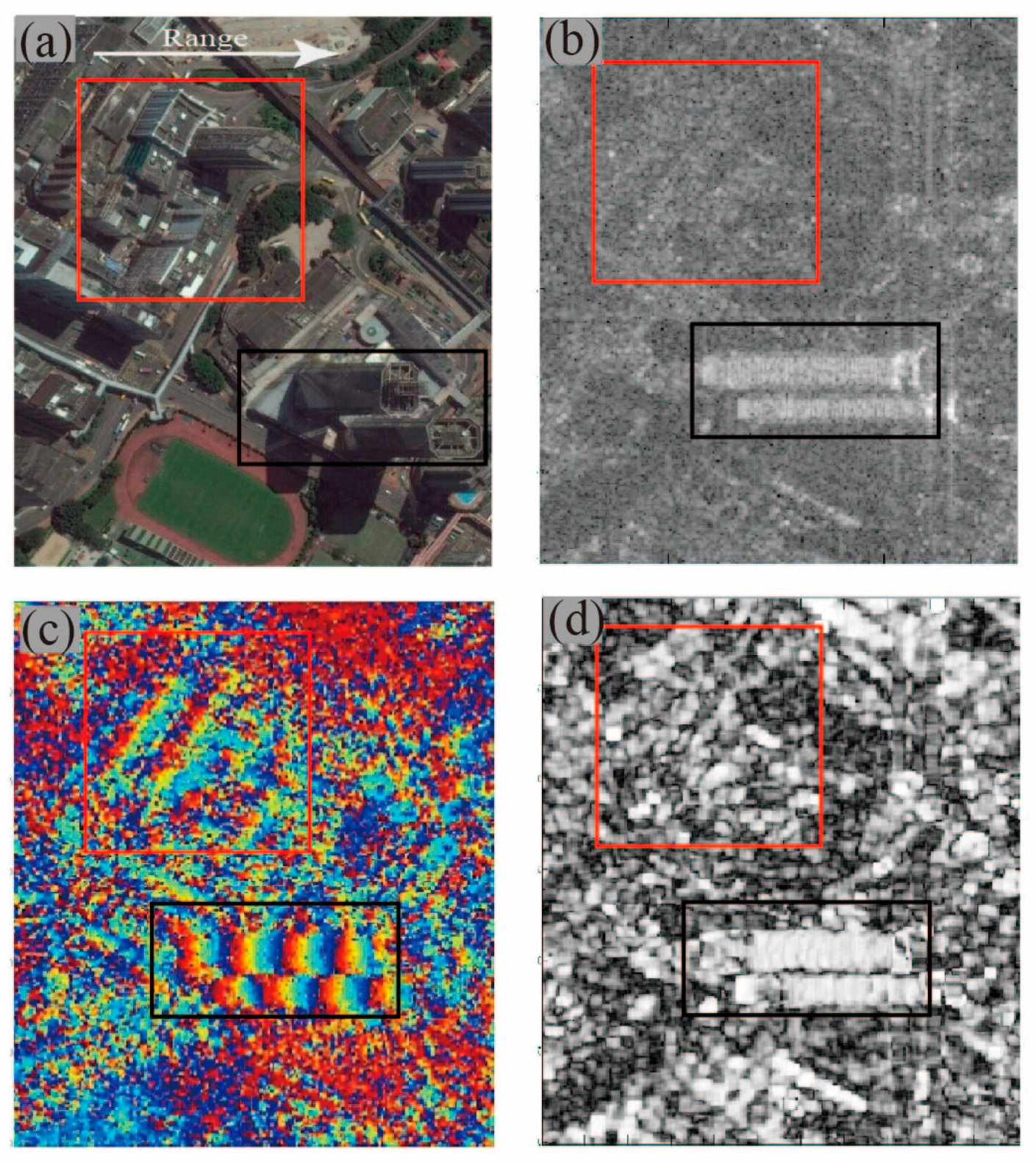
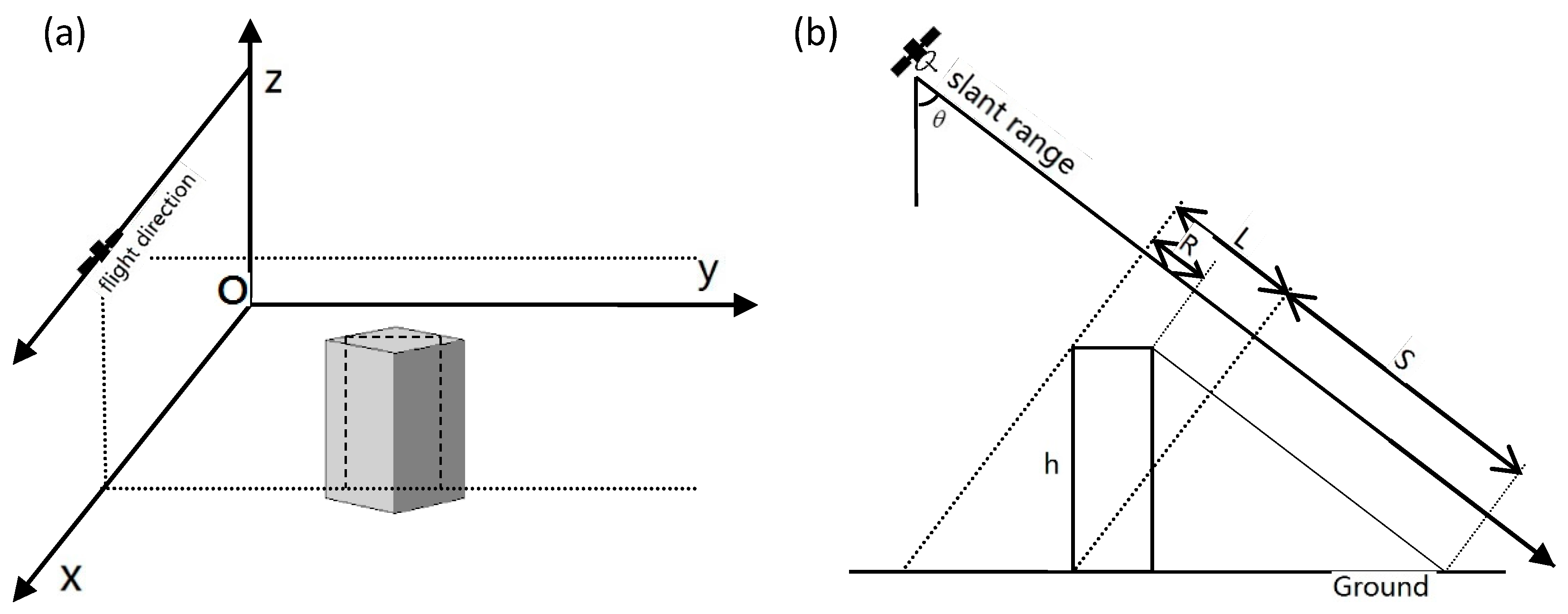
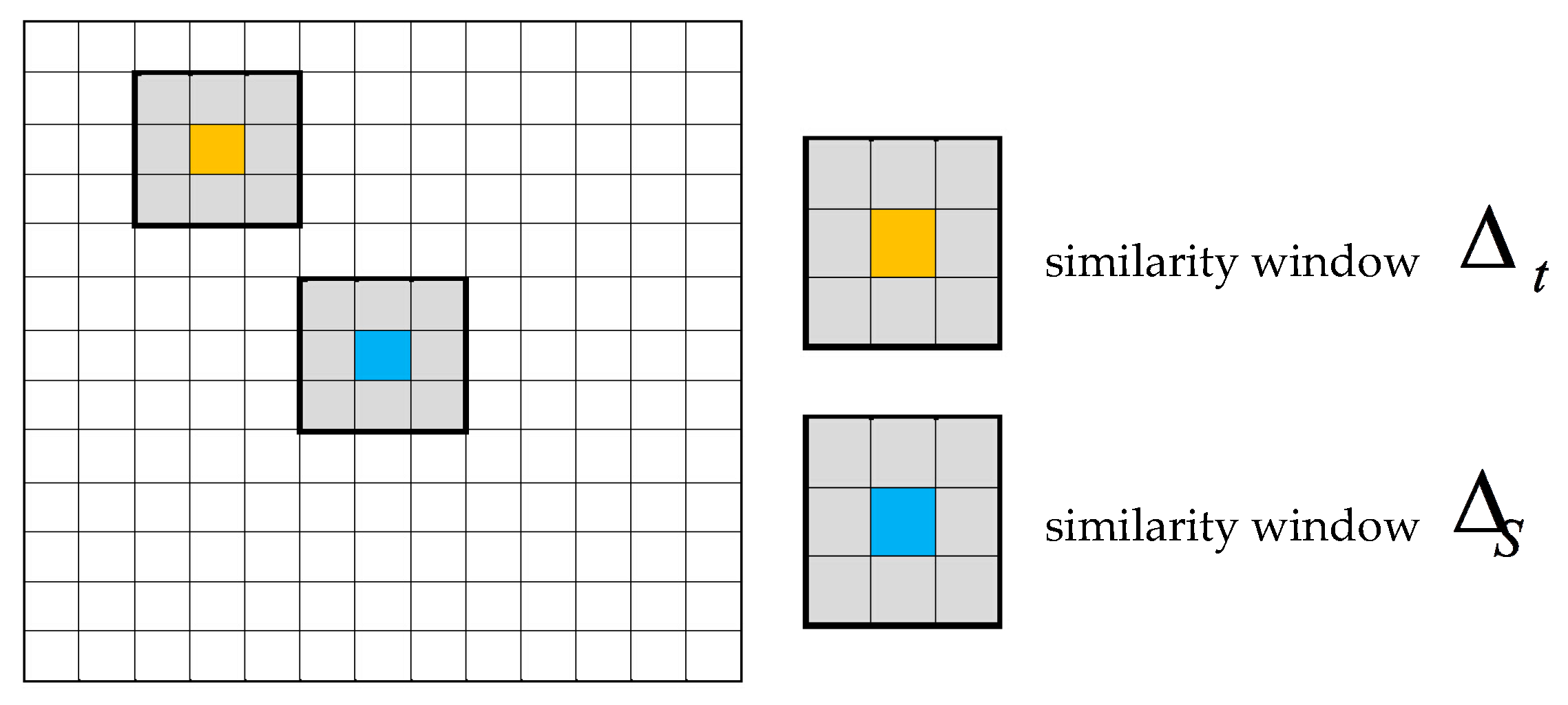

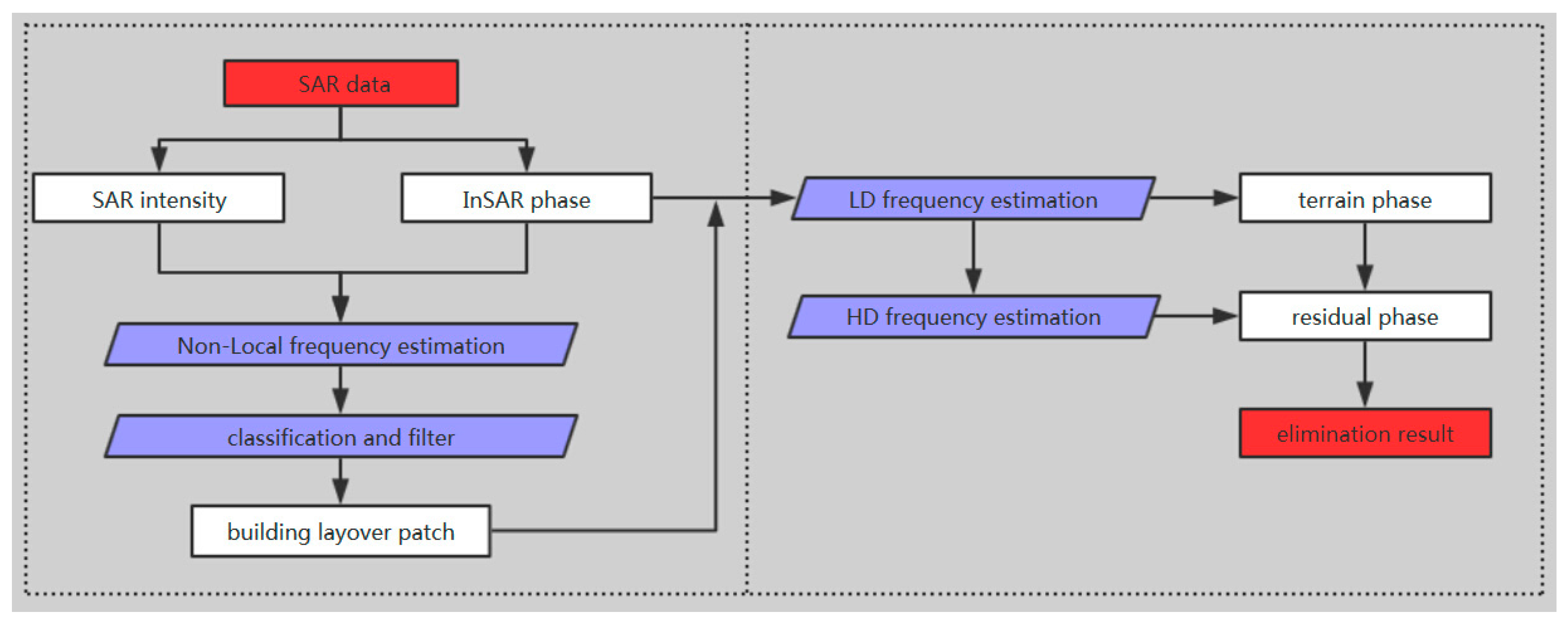
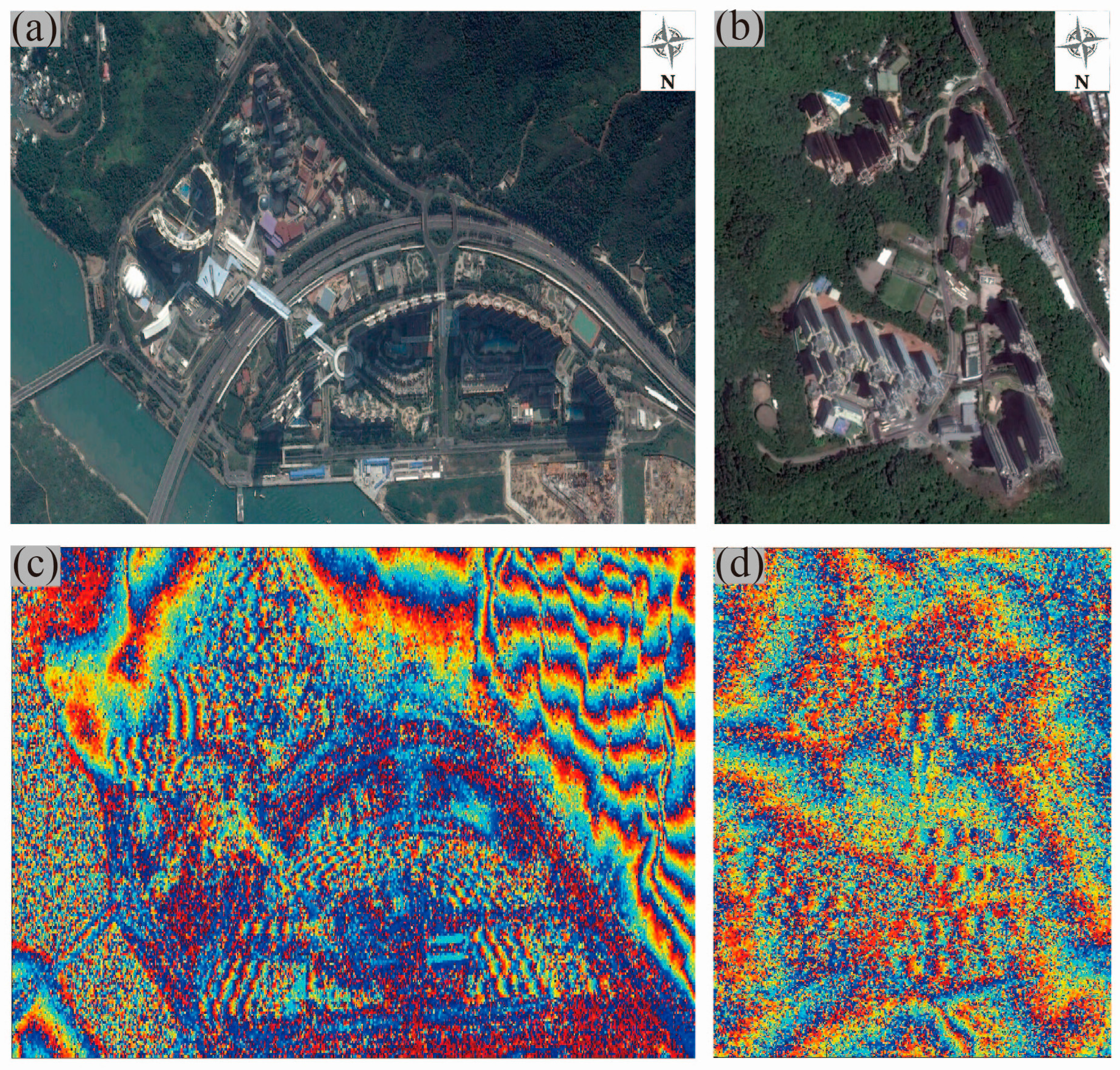
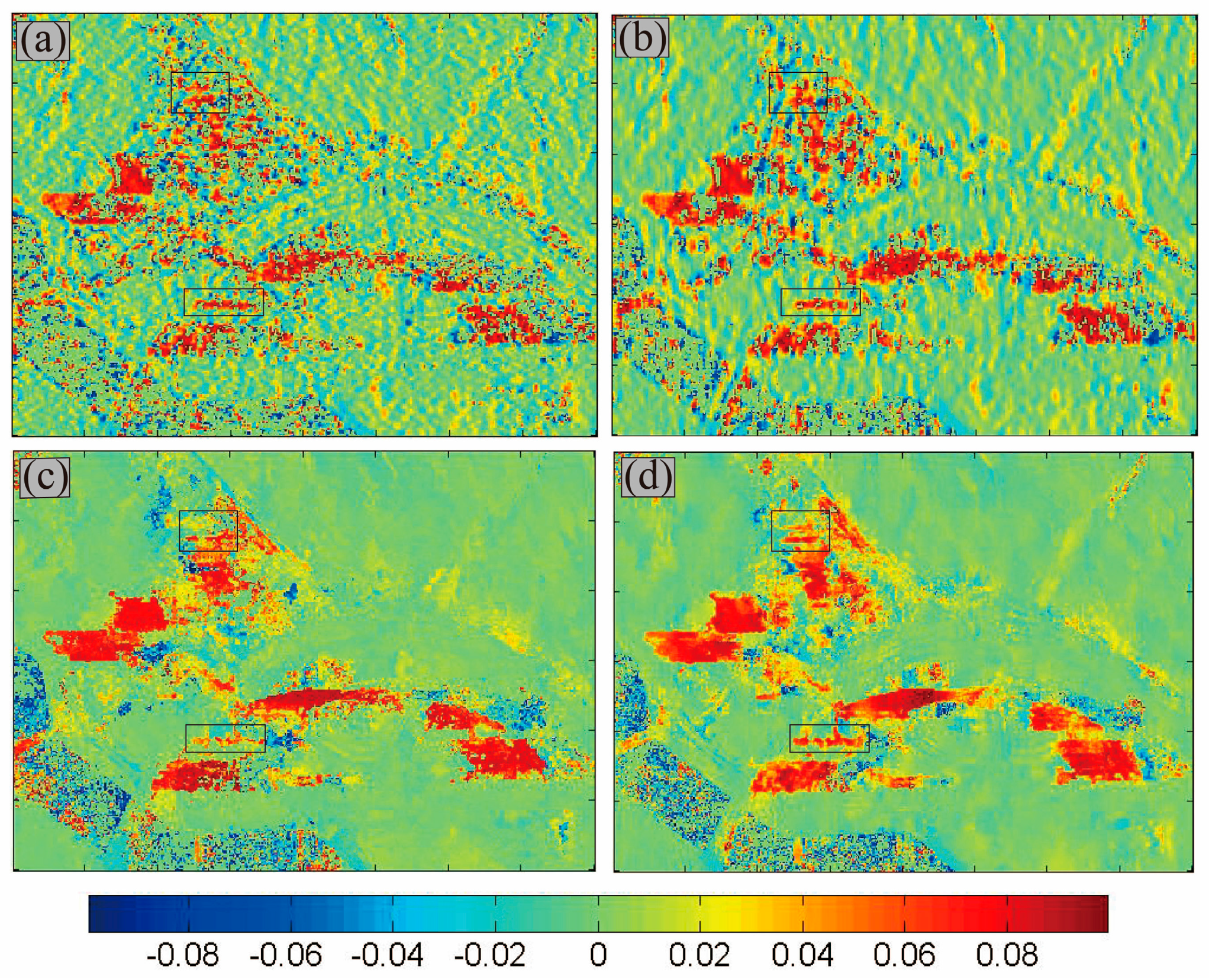
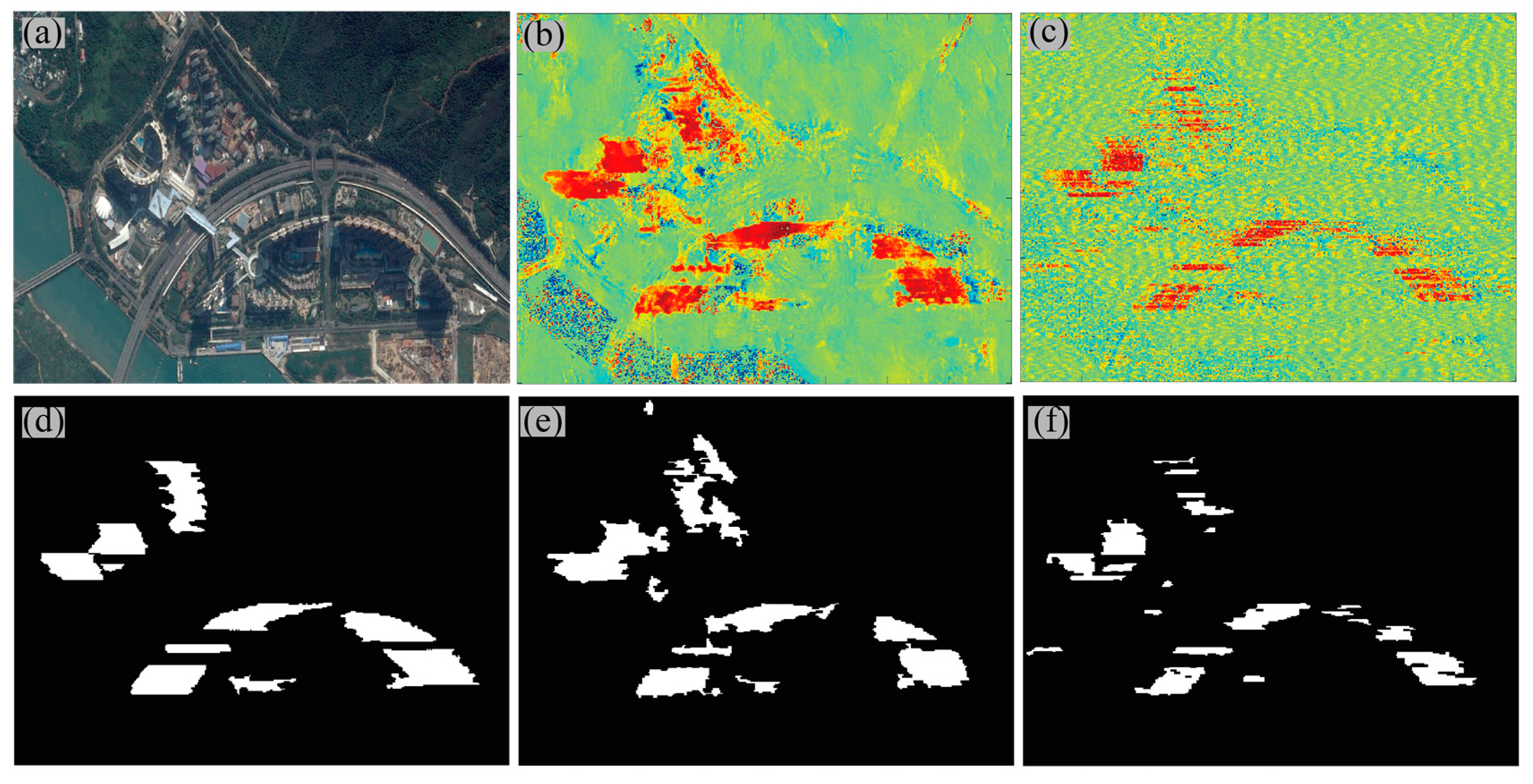
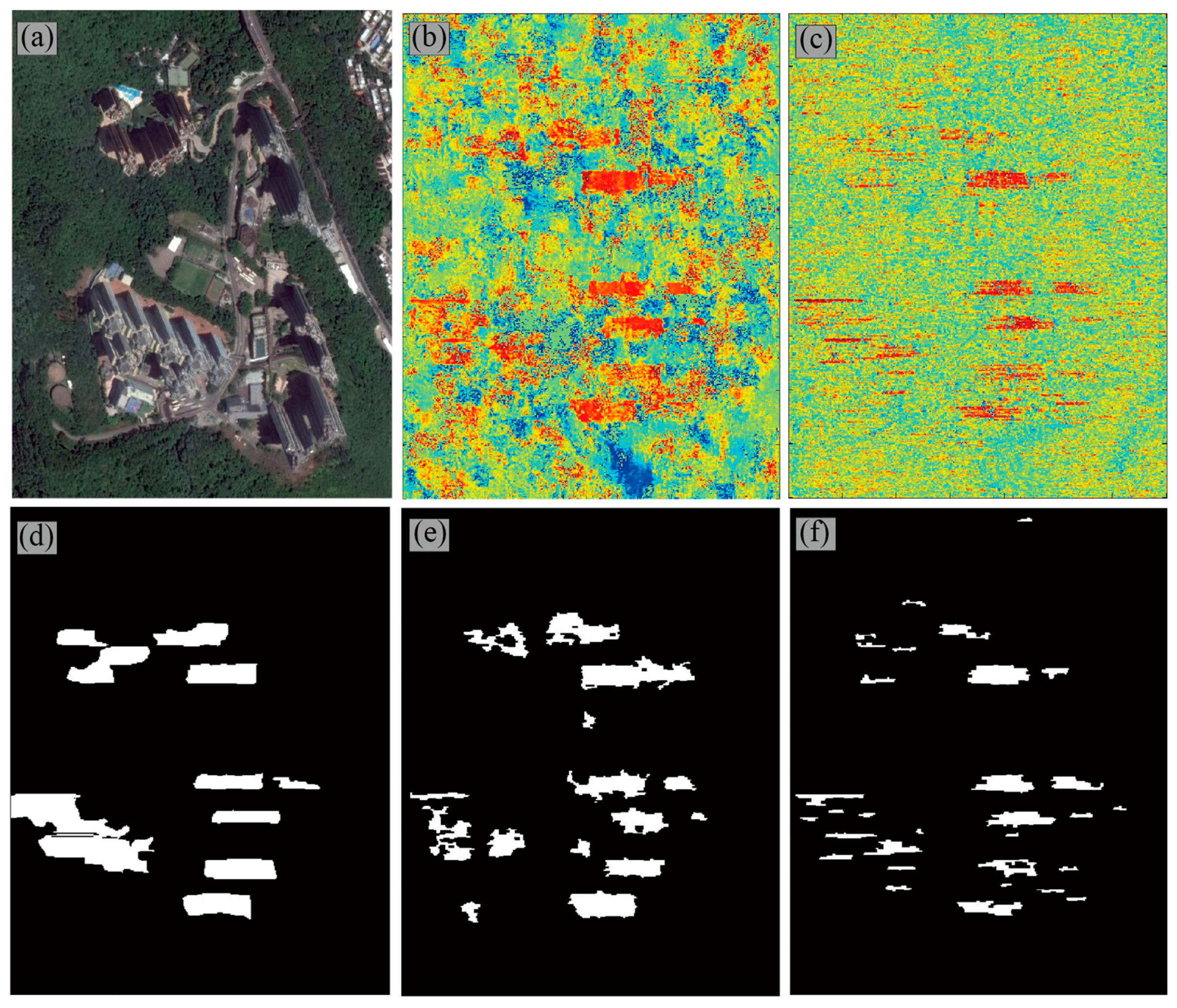
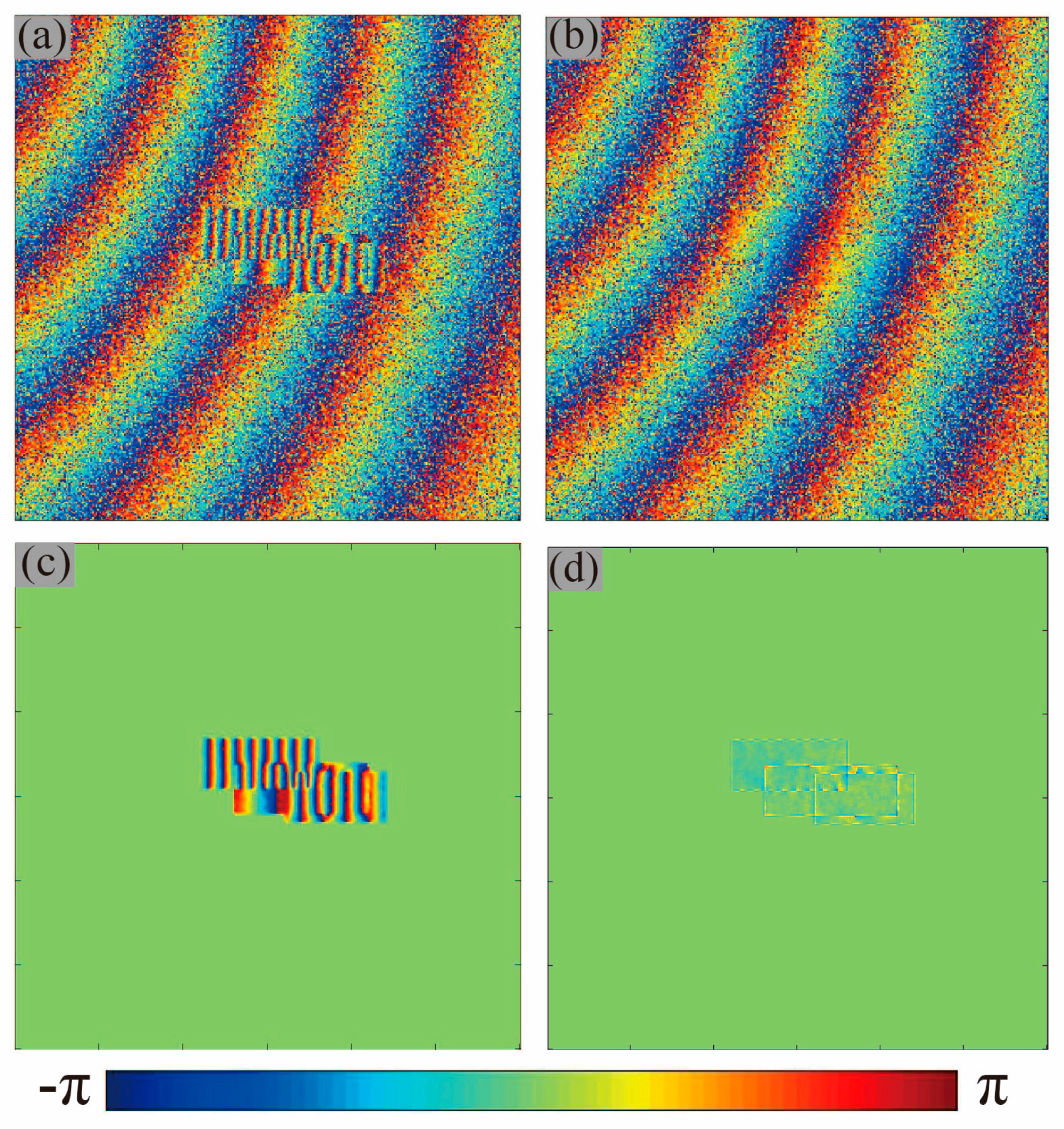
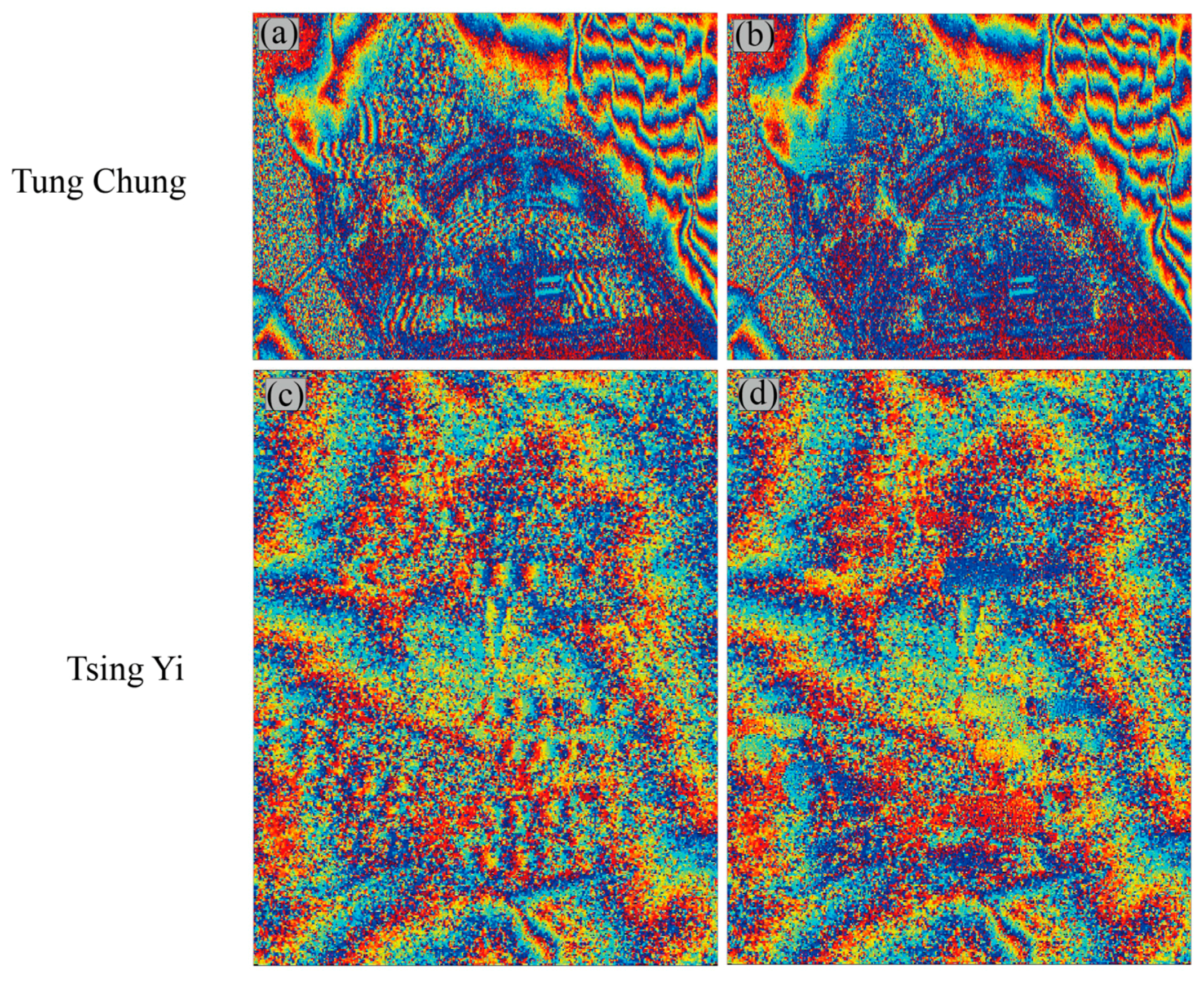
| Sensor | Acquisition Date | Incidence Angle | Perpendicular Baseline | Pixel Spacing | |
|---|---|---|---|---|---|
| TerraSAR-X | 1 January 2013 | 36.10° | 285.56 m | Range: 2.73 m | 20 m |
| TanDEM-X | Azimuth: 4.05 m |
| Frequency Detector | Ramp Detector | ||
|---|---|---|---|
| Tung Chung | RMSE | 0.1954 | 0.2075 |
| SSIM | 0.8694 | 0.8678 | |
| Tsing Yi | RMSE | 0.2498 | 0.2535 |
| SSIM | 0.8570 | 0.8527 | |
| Satellite Altitude | Incidence Angle | Perpendicular Baseline | Pixel Spacing | |
|---|---|---|---|---|
| 510 km | 33° | 200 m | Range: 3 m Azimuth: 3 m | ~28 m |
© 2017 by the authors. Licensee MDPI, Basel, Switzerland. This article is an open access article distributed under the terms and conditions of the Creative Commons Attribution (CC BY) license (http://creativecommons.org/licenses/by/4.0/).
Share and Cite
Zhu, J.; Ding, X.; Li, Z.; Zhu, J.; Xu, B. High-Rise Building Layover Exploitation with Non-Local Frequency Estimation in SAR Interferograms. Remote Sens. 2017, 9, 579. https://doi.org/10.3390/rs9060579
Zhu J, Ding X, Li Z, Zhu J, Xu B. High-Rise Building Layover Exploitation with Non-Local Frequency Estimation in SAR Interferograms. Remote Sensing. 2017; 9(6):579. https://doi.org/10.3390/rs9060579
Chicago/Turabian StyleZhu, Jun, Xiaoli Ding, Zhiwei Li, Jianjun Zhu, and Bing Xu. 2017. "High-Rise Building Layover Exploitation with Non-Local Frequency Estimation in SAR Interferograms" Remote Sensing 9, no. 6: 579. https://doi.org/10.3390/rs9060579





